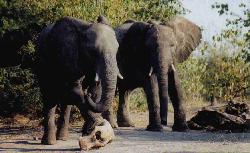African Elephant - Loxodonta africana
 Chobe National Park offers excellent elephant viewing. Numerous breeding herds can be seen along the Chobe and Linyanti Rivers and around Nogatsaa and Tchinga campsites as the winter deepens. The water-hole at Savuti (also spelled Savute) attracts large numbers of bulls which one can usually approach more savely than the bredding herds. Moremi and Okavango also boast large numbers of elephant which can, however, prove more elusive than their counterpats in Chobe due to the denser vegetation.
Chobe National Park offers excellent elephant viewing. Numerous breeding herds can be seen along the Chobe and Linyanti Rivers and around Nogatsaa and Tchinga campsites as the winter deepens. The water-hole at Savuti (also spelled Savute) attracts large numbers of bulls which one can usually approach more savely than the bredding herds. Moremi and Okavango also boast large numbers of elephant which can, however, prove more elusive than their counterpats in Chobe due to the denser vegetation.
The African elephant is the largests living land animal and weighs up to 5,400 kg. It inhabits the savannah, brush, forest, river valleys, and semi-desert regions of Africa south of the sahara desert.
Besides its greater size, it differs from the Asian elephant in having larger ears and tusks, a sloping forehead, and two "fingers" at the tip of its trunk, compared to only one in the Asian species.
As vegetarians, elephants require much food, sometimes consuming more than 225 kg of plant matter a day. Their trunk is employed to pull branches off trees, uproot grass, pluck fruit, and to place food in their mouths. The trunk is also used for smell, touch and in drinking, greeting or throwing dust for dust baths. In both sexes, the two incisor teeth of the upper jaw grow to form tusks, and it is for this ivory, used at one time in the manufacture of piano keys, billiard balls, and other objects, that hunters have slaughtered thousands of these magnificent animals.







